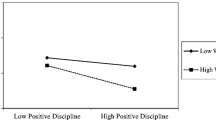Abstract
The present study examines the impact of child and parent gender on parental violence across age span of children and their parents in Hong Kong Chinese families. A randomly selected community sample of 1,019 households was surveyed. Results indicate that, in general, boys experience more frequent parental violence than girls and mothers engage in more violent behaviors against their children than fathers. Parental violence shows a curvilinear pattern with age of children, peaking at age 8 for boys and age 3 for girls. There is a pattern of declining frequency of parental violence as parental age increases across child gender. Fathers exhibit an inverted “U” pattern of violent behavior against their children, with a peak around age 31–40, while mothers have a steadily declining trend until age 46. Separate parental violence indices are constructed for boys and girls.
Similar content being viewed by others
REFERENCES
American Association for Protecting Children (1986), Highlights of Official Child Neglect and Abuse Reporting, 1984, Author, Denver, CO.
American Humane Association (1986). Highlights of Official Child Neglect and Abuse Reporting, 1984. Author, Denver, CO.
Barling, J., O'Leary, K. D., Jouriles, E. N., Vivian, D., and MacEwen, K. E. (1987). Factor similarity of the Conflict Tactics Scale across samples, spouses, and sites: Issues and Implications. J. Fam. Viol. 2: 37-53.
Belsky, J. (1980). Child maltreatment: An ecological integration. Am. Psychologist 35: 320-335.
Chan, Y. C. (1994). Parenting stress and social support of mothers who physically abuse their children in Hong Kong. Child Abuse Negl. 18: 261-269.
D'Antonioy, I. J., Darwish, A. M., and McLeany, M. (1993). Child maltreatment: International perspectives. Maternal-Child Nurs. J. 21: 39-52.
Doek, J. E. (1991). Management of child abuse and neglect at the international level: Trends and perspectives. Child Abuse Negl. 15: 51-56.
Finkelhor, D., and Dziuba-Leatherman, J. (1994). Victimization of children. Am. Psychologist 49(3): 173-183.
Finkelhor, D., and Korbin, J. (1988). Child abuse as an international issue. Child Abuse Negl. 12: 3-23.
Garbarino, J. (1977). The human ecology of child maltreatment: A conceptual model for research. J. Marr. Fam. 39: 721-735.
Gelles, R. J. (1989). Child abuse and violence in single-parent families: Parent absence and economic deprivation. Am. J. Orthopsychiatry 59(4): 492-501.
Gil, D. G. (1970). Violence Against Children: Physical Child Abuse in the United States, Harvard University Press, Cambridge, MA.
Goodwin, R., and Tang, C. (1996). Chinese personal relationships. In Bond, M. H. (ed.), The Handbook of Chinese Psychology, Oxford University Press, Hong Kong, pp. 294-308.
Hemenway, D., Solnick, S., and Carter, J. (1994). Child-rearing violence. Child Abuse Negl. 18(12): 1011-1020.
Ho, Y. F. (1981). Traditional patterns of socialization in Chinese society. Acta Psychologica Taiwanica 23(2): 81-95.
Ho, Y. F. (1987). Chinese patterns of socialization: A critical review. In Bond, M. H. (ed.), The Psychology of Chinese People, Oxford University Press, Hong Kong, pp. 1-35.
Ho, Y. F. (1996). Filial piety and its psychological consequences. In Bond, M. H. (ed.), The Handbook of Chinese Psychology, Oxford University Press, Hong Kong, pp. 155-165.
Jouriles, E. N., and Norwood, W. D. (1995). Physical aggression towards boys and girls in families characterized by the battering of women. J. Fam. Psychol. 9(1): 69-78.
Korbin, J. E. (1991). Cross-cultural perspectives and research directions for the 21st century. Child Abuse Negl. 15: 67-77.
Levinson, D. (1989). Family violence in a cross-cultural perspective, Sage, CA.
Lieh-Mak, F., Chung, S. Y., and Liu, Y. W. (1983). Characteristics of child battering in Hong Kong: A controlled study. Br. J. Psychiatry 142: 89-94.
Milner, J. (1994). Assessing physical child abuse risk: The Child Abuse Potential Inventory. Clinical Psychology Review 14(6): 547-583.
Olsen, L. J., and Holems, W. M. (1986). Youth at risks: Adolescents and maltreatment. Children Youth Serv. Rev. 8: 13-35.
Sedlak, A. J. (1991). Supplementary Analyses of Data on the National Incidence of Child Abuse and Neglect, Westat, Rockville, MD.
Straus, M. A. (1979). Measuring intrafamily conflict and violence: The Conflict Tactics (CT) Scales. J. Marr. Fam. 41: 75-88.
Straus, M. A. (1992). The Conflict Tactics Scales and its critics: An evaluation and new data on validity and reliability. In Straus, M. A., and Gelles, R. J. (eds.), Physical Violence in American Families, Transaction Publishers, New Brunswick, NJ, pp. 49-71.
Straus, M. A., Gelles, R. J., and Steinmetz, S. K. (1980). Behind Closed Doors: Violence in the American Families, Transaction Publishers, New Brunswick, NJ.
Tang, C. (1994). Prevalence of spouse aggression in Hong Kong. J. Fam. Viol. 9: 347-358.
Tang, C. (1996). Adolescent abuse in Hong Kong Chinese families. Child Abuse Negl. 20(9): 873-878.
Tang, C., and Davis, C. (1996). Child abuse in Hong Kong revisited after 15 years: Characteristics of victims and abusers. Child Abuse Negl. 20(12): 1201-1206.
Wauchope, BA., and Straus, M. A. (1992). Physical punishment and physical abuse of American children: Incidence rates by age, gender, and occupational class. In Straus, M. A., and Gelles, R. J. (eds.), Physical Violence in American Families, Transaction Publishers, New Brunswick, NJ, pp. 133-143.
Wolfner, G. D., and Gelles, R. J. (1993). A profile of violence toward children: A national study. Child Abuse Negl. 17: 197-212.
Wu, D. (1981). Child abuse in Taiwan. In Korbin, J. E. (ed.), Child Abuse and Neglect: Cross-Cultural Perspectives, University of California Press, Berkeley, CA, pp. 139-165.
Rights and permissions
About this article
Cite this article
Tang, C.Sk. Frequency of Parental Violence Against Children in Chinese Families: Impact of Age and Gender. Journal of Family Violence 13, 113–130 (1998). https://doi.org/10.1023/A:1022868922408
Issue Date:
DOI: https://doi.org/10.1023/A:1022868922408




